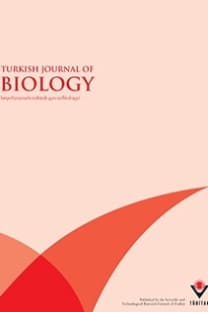Evaluation of anti-Plasmodium berghei activity of crude and column fractions of extracts from Withania somnifera
Key words: Antimalarial activity, in vivo, Plasmodium berghei, Withania somnifera
Evaluation of anti-Plasmodium berghei activity of crude and column fractions of extracts from Withania somnifera
___
- Olliaro P, Taylor WRJ, Rigal J. Controlling malaria: challenges and solutions. Trop Med Int Health 6: 922–927, 2001.
- Villamor E, Fataki MR, Mbise RL et al. Malaria parasitaemia in relation to HIV status and vitamin A supplementation among school children. Trop Med Int Health 8: 1051–1061, 2003.
- World Health Organization (WHO). World Malaria Report. WHO. Geneva, Switzerland; 2011.
- O’Neill MJ, Bray DH, Boardman P et al. Plants as a source of antimalarial drugs part 1. In vitro test method for the evaluation of crude extracts from plants. Planta Med 51: 394–398, 1985.
- Benoit F, Valentin A, Pelissier Y et al. In vitro antimalarial activity of vegetal extracts used in West African traditional medicine. Am J Trop Med Hyg 54: 67–71, 1996.
- Sharafati-Chaleshtori R, Sharafati-Chaleshtori F, Rafieian M. Biological characterization of Iranian walnut (Juglans regia) leaves. Turk J Biol 35: 635–639, 2011.
- Orhan İE, Özçelik B, Kartal M et al. Antimicrobial and antiviral effects of essential oils from selected Umbelliferae and Labiatae plants and individual essential oil components. Turk J Biol 36: 239–246, 2012.
- Abelson PH. Medicine from plants. Science 247: 513, 1990.
- Kupcham SM. Drugs from natural products: plant source in drug discovery, science, and development. J Am Chem Soc 6: 311–318, 1971.
- Dikasso D, Mekonnen E, Debella A et al. Antimalarial activity of Withania somnifera L. Dunal extracts in mice. J Ethiop Med 44: 279–285, 2006.
- Satyavivad J, Soonthornchareonnon N, Somanabandhu A et al. Toxicological and antimalarial activity of Eurycomalactone and Eurycoma longifolia Jack extracts in mice. Thai J Phytopharm 5: 14–27, 1998.
- Tchoumbougnang F, Zollo PH, Dagne E et al. In vivo antimalarial activity of essential oils from Cymbopogon citratus and Ocimum gratissimum on mice infected with Plasmodium berghei. Planta Med 71: 20–23, 2005.
- Li L, Cu M, Warhurst C. Effect of qinghaous and related compounds on incorporation of [G-3 H] hypoxanthin by Plasmodium falciparum in vitro. Trans R Soc Trop Med Hyg 77: 522–524, 2003.
- Devi CU, Valecha N, Atul PK et al. Antiplasmodial effect of three medicinal plants: a preliminary study. Curr Sci 80: 917– 919, 2001.
- Bogale M, Petros B. Evaluation of the antimalarial activity of some Ethiopian traditional medicinal plants against P. falciparum in vitro. SINET 19: 233–243, 1996.
- Muregi FW, Chharbra SC, Njagi ENM et al. In vitro antiplasmodial activity of some plants used in Kisii, Kenya against malaria and their chloroquine potentiation effects. J Ethnopharmacol 84: 235–239, 2003.
- Bertin G, Ndam TN, Jafari-Guemori, S et al. High prevalence of Plasmodium falciparum pfcrt K76T mutation in pregnant women taking chloroquine prophylaxis in Senegal. J Antimicrob Chemother 55: 788–791, 2005.
- Fennell CW, Lindsey KL, McGaw LJ et al. Assessing African medicinal plants for efficacy and safety: pharmacological screening and toxicology. J Ethnopharmacol 94: 205–217, 200 Singh G, Sharma PK, Dudhe R et al. Biological activities of Withania somnifera. Ann Biol Res 1: 56–63, 2010.
- Owais M, Sharad KS, Shebaz A et al. Antibacterial efficacy of Withania somnifera (ashwagandha) an indigenous medicinal plant against experimental murine Salmonellosis. Phytomedicine 12: 229–235, 2005.
- ISSN: 1300-0152
- Yayın Aralığı: 6
- Yayıncı: TÜBİTAK
Zerihun Teklemariam DAME, Beyene PETROS, Yalemtsehay MEKONNEN
An ethnobotanical survey in selected towns of the Mediterranean subregion (Turkey)
Galip AKAYDIN, İşıl ŞİMŞEK, Zekiye Ceren ARITULUK, Erdem YEŞİLADA
Toxicities of diuron and irgarol on the hatchability and early stage development of Artemia salina
The effects of zinc chloride during early embryonic development in zebrafish (Brachydanio rerio)
Melek KÜÇÜKOĞLU, Uğur Seçil BİNOKAY, Ayper Boğa PEKMEZEKMEK
Sayıt SARGIN, Yüksel GEZGİN, Rengin ELTEM, Fazilet VARDAR
Hilal SUSURLUK, Umut TOPRAK, Mehmet Oktay GÜRKAN
Memory-enhancing effects of the leptin hormone in Wistar albino rats: sex and generation differences
Alper KARAKAŞ, Hamit COŞKUN, Fevziye Umut KIZILKAYA
Ranjetta POOBATHY, Uma Rani SINNIAH, Xavier RATHINAM, Sreeramanan SUBRAMANIAM
Seema POROB, Sagar NAYAK, Areena FERNANDES, Priyanka PADMANABHAN
Improved salt tolerance of jute plants expressing the katE gene from Escherichia coli
Md. Shahidul ISLAM, Muhammad Shafiul AZAM, Sazia SHARMIN, Abu Ashfaqur SAJIB, Md. Maksudul ALAM, Md. Shamim REZA, Rajib AHMED, Haseena KHAN
